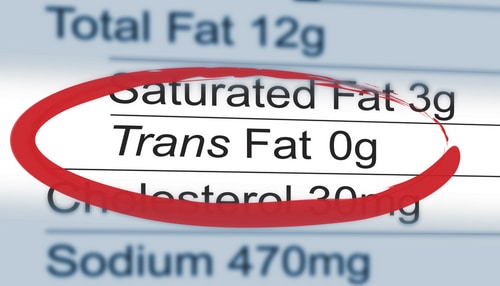
Fortunately, trans-fats have been removed from some foods, and manufacturers proudly display on the label that their product contains zero grams of trans-fat. Unfortunately, zero grams doesn’t always mean a product is trans-fat free. The FDA allows companies to say their product contains zero grams of trans-fat if it contains less than 0.5 grams of trans-fat per serving.
Why is this a problem? Research shows that even small amounts of trans-fats are unhealthy, and you get some trans-fat naturally when you eat meat and dairy products. That’s why it’s important to stay away from packaged products that aren’t completely free of trans-fat. Trans-fats have been linked with a greater risk of heart disease and stroke, and they can even affect your mental health. A recent study linked trans-fats with increased irritability and aggression. If zero grams of trans-fat on the label isn’t a reliable indicator that a product is trans-fat free, how do you know whether it’s safe to buy?
Look for Hydrogenated Oils on the Label
To see if a product contains trans-fat, look beyond the nutritional label to the ingredient list. Even if the label says zero grams of trans-fat, there may still be as much as 0.49 grams of trans-fat per serving. If you look at the ingredient list and see any type of hydrogenated or fractionated oil listed, the product contains some trans-fat. Even foods that are marketed as “healthy” may contain some quantity of these unhealthy fats.
Some products to watch out for are cake and cookie mixes, granola bars, powdered soup, and dip mixes, frozen waffles, frozen fish sticks, biscuits, croissants, pizza, crackers, pre-packaged bread, pie crusts, pastries, cookies, microwave popcorn, and margarine. Hard, stick margarine usually contains higher levels of trans-fat than softer margarine in tubs.
Most of these foods wouldn’t make a list of foods that are good for you, so simply making healthier food choices reduces your exposure to trans-fat. Eliminating most packaged and processed foods from your diet are the best way to stay trans-fat free. If that isn’t practical, read the ingredient list, and put products back on the shelf that contain hydrogenated oil.
Restaurants Are Trickier
Even if you eliminate packaged foods from your grocery cart, you may be getting a hefty load of trans-fat when you eat out. If a restaurant uses margarine to prepare foods, there’s probably trans-fat in the food they’re serving you. There are kinds of margarine that are completely trans-fat free such as Smart Balance, but many others still contain small amounts of trans-fat, even ones you find at the health food store. Some of the larger chain and fast-food restaurants now cook with oils that meet the criteria for “zero trans-fat,” although they still contain small quantities of hydrogenated oil.
Many smaller mom-and-pop restaurants still prepare foods with margarine and hydrogenated oils. These less healthy oils are less costly, have a longer shelf-life and add an appealing flavor to food. That makes them a popular choice with independent restaurants. Before eating out, call ahead of time and ask what type of cooking oil they use and if they use margarine or butter when they prepare food. If you don’t get a satisfying answer, dine elsewhere.
References:
Medscape.com. “Dietary Trans Fats Linked to Aggression”
Related Articles By Cathe:
Can You Breathe a Sigh of Relief Now That Trans-Fats Are Banned?
5 of the Worst Ingredients in Processed Foods

